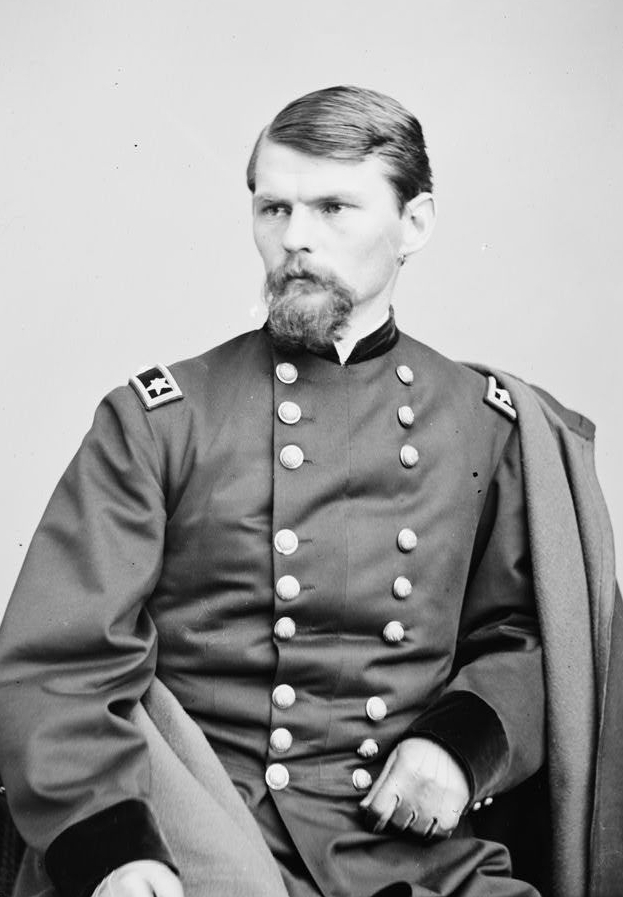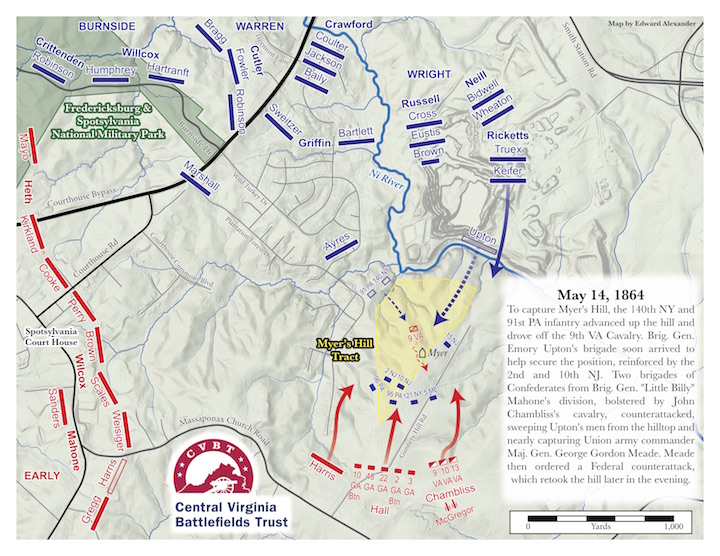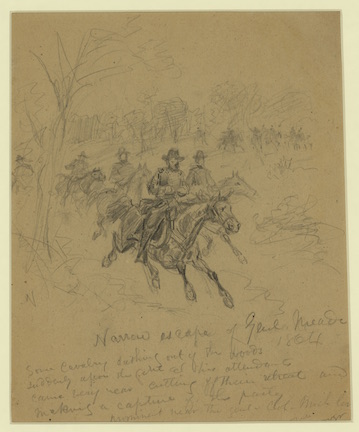Breaking Preservation News: CVBT to Expand the Story of Spotsylvania Court House with Newest Battlefield Acquisition


We are excited to share some “breaking news” from our friends at the Central Virginia Battlefields Trust, who have just announced a major new effort at Spotsylvania Court House:
While the 1864 battle of Spotsylvania Court House is best known for the May 12 fighting at the “Bloody Angle,” there was more to the battle than just the Mule Shoe Salient.
And now the Central Virginia Battlefields Trust is excited to announce the acquisition of a vitally important piece of property that will open up more of the story of the battle of Spotsylvania Court House: Myer’s Hill.
“Myer’s Hill is one of the most important pristine sites remaining to be preserved on the Spotsylvania Court House battlefield,” says award-winning historian Gordon Rhea, whose work has focused on the 1864 Overland Campaign, including Spotsylvania Court House. “It is imperative that this key location be saved to enable future generations to walk the ground and understand the momentous events that transpired there.”
Central Virginia Battlefields Trust now has the opportunity to preserve more than 73.3 acres of this important property.
“The story of the second week of fighting at Spotsylvania Court House often gets overlooked in favor of the dramatic story at the Mule Shoe Salient, but there is a tremendous amount we can learn from that second week,” explains historian Chris Mackowski, who has written extensively about the battle of Spotsylvania Court House. “The acquisition of Myer’s Hill will open up that broader story, so people can more fully understand the battle and the commanders.”

The story of Myer’s Hill features local Spotsylvania County troops, colorful Zouaves, a newly minted brigadier general, one of the most successful merchants in Spotsylvania County, and the near-capture of the Army of the Potomac’s commander, George Gordon Meade.
The May 14, 1864, fighting for Myer’s Hill pitted Union Brigadier General Emory Upton, a bold “young Turk” fresh off an innovative attack against the Mule Shoe on May 10, against one of the most irascible, hard-fighting generals in the Confederate army, Robert E. Lee’s “Bad Old Man,” Maj. Gen. Jubal Early.
“Federals hoped to outflank Lee on Lee’s right, so they shifted half the army for a major attack in the Myer’s Hill sector of the battlefield, but muddy roads worked against them,” Mackowski says. “Confederate artillery on Myer’s Hill threatened the new Union position, so Meade gave permission for his men to take it.”
First up the hill were two Fifth Corps regiments, the 140th New York and the 91st Pennsylvania infantry—two Zouave units wearing brightly colored uniforms patterned after the French foreign legion. They drove away Confederate cavalrymen from the 9th Virginia Cavalry, which consisted of horsemen raised from the local area. Independently, Upton led 800 men on a charge to take the hill but found it occupied by the Zouaves by the time he reached the summit. He deployed his men in a defensive position to further secure it.

“Lee still wasn’t sure what the Federals were up to by this point, so he ordered Early to retake the hill,” Mackowski says. “In the meantime, Meade rode to the hilltop to see the situation for himself. In the ensuing fight, Confederate cavalry nearly captured Meade, who only barely escaped.”
Angry, Meade ordered the hill re-taken. This time, four brigades swept forward, but by that time, Lee had better determined Federal intentions and withdrew Early’s men to a more secure position. Federals retook the hill and occupied it for the remainder of the battle, which lasted through May 21.
“Spotsylvania is one of the seismic battles of the Civil War,” says legendary historian Ed Bearss, former chief historian for the National Park Service. “At Myer’s Hill Grant was checked, but he goes back and takes it. The fighting for the hill results in a crucial two-day delay for his army.”
This significant acquisition of Myer’s Hill comes with a purchase price of $450,000.00. We also have much work to do on the property. CVBT will need to raise $460,000.00 to cover our immediate costs.
Fortunately, we again have the opportunity for $1-to-$1 matching funds that will double donations. This is an increasingly rare opportunity to preserve an almost completely intact battlefield—one that history has paid little attention to nevertheless is so important to the entire story.
Myer’s Hill counts as one of CVBT’s larger preservation efforts in the twenty-two years we have been saving our history. The good news is that we have had other efforts in this price range and we have successfully satisfied those challenges. Not long ago, for instance, we completed the $1 million pledge to help save Slaughter Pen Farm. Having accomplished a goal as lofty as that, we certainly can dig deep and make short work of this important project.
Make no mistake: this is a large challenge for a small organization such as CVBT. You can donate here.
Earlier this year, CVBT preserved 14.4 acres along Brock Road where the Fifth Corps launched part of its attacks against Laurel Hill on May 8, 1864. Coupled with this new opportunity to preserve Myer’s Hill, CVBT will save 87.8 acres of important hallowed ground from the battle of Spotsylvania Court House this year alone.
That will bring our total at Spotsylvania up to 132.7 acres—part of the nearly 1,300 acres CVBT has preserved on all four of the area’s major battlefields.
Battlefields are “outdoor classrooms” and provide an invaluable place to study and reflect upon our past. Stay tuned for additional exciting news and information as CVBT works to preserve the Myer’s Hill.
CVBT continues to preserve the ground from which we may hear the faint echoes of battle, and the voices of those who gave so much in a defining moment of our still-young country.
This is outstanding news!
I humbly suggest we make Myers Hill the driving trip for next year’s symposium.
We already have next year’s tour lined up (details coming soon!). Myer’s Hill is difficult to access and maneuver around on at present, particularly in summer when the foliage is thick. That said, CVBT is looking at providing some access during its annual meeting in the spring, so there might be an opportunity then for attendees to tour the property. The CVBT annual meeting is well worth attending anyway, but this’ll be an extra cool treat!
So excited to hear this! Go CVBT!!